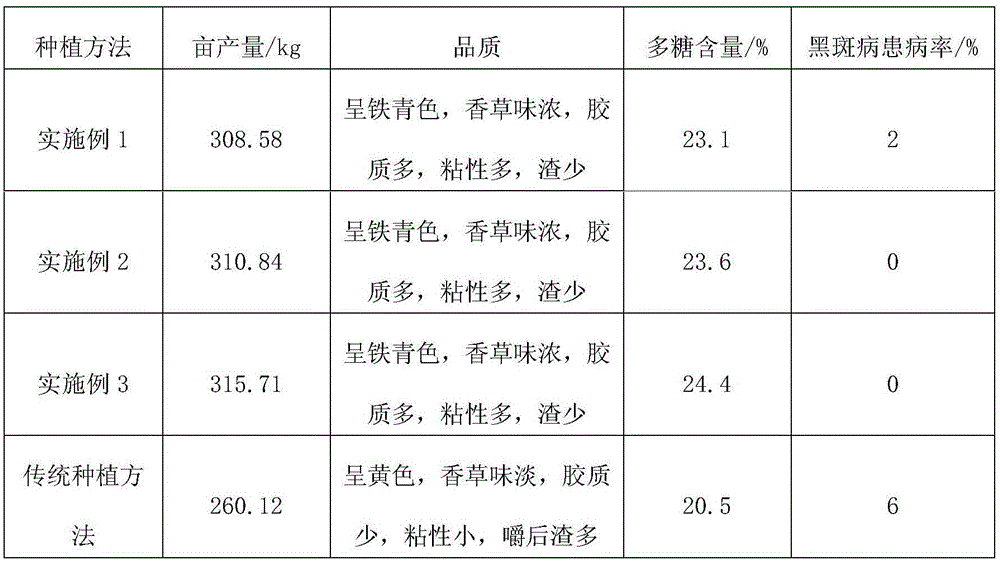Method for planting dendrobium officinales on tree
A Dendrobium candidum and bark technology, which is applied in the field of Dendrobium candidum planting, can solve problems such as being unable to meet the requirements of Dendrobium candidum nutrient, drainage, water retention, and fertilizer retention, not in line with the concept of healthy ecology, and affecting the quality of Dendrobium candidum. Achieve the effects of reducing the incidence of diseases and insect pests, good water and fertilizer retention performance, and conducive to growth
- Summary
- Abstract
- Description
- Claims
- Application Information
AI Technical Summary
Problems solved by technology
Method used
Image
Examples
Embodiment 1
[0035] The method of planting Dendrobium candidum on trees in this embodiment includes the following steps:
[0036] (1) Select tree species: In the woods with a forest coverage rate of 80%, an average temperature of 18°C, an annual rainfall of 1200mm, and an annual sunshine time of more than 2400h, camphor trees are selected as the planting tree species, and the shade rate of the woods 78%;
[0037] (2) Laying substrate: On the selected camphor tree bark, cut off the outer layer of bark around the trunk to obtain an upward groove on the bark. A through hole is drilled on the side wall of the groove. The interval between adjacent grooves on the camphor tree is 40 cm, and a substrate is laid in the grooves. The substrate consists of 10 parts by weight of pond mud, 3 parts of Chinese fir shavings, 5 parts of camphor bark, and natural methylglycine 1 part of proline, 18 parts of moss, 4 parts of bamboo wood block, 1.5 parts of konjac glucomannan-acrylic acid graft copolymer, 10 parts...
Embodiment 2
[0043] The method of planting Dendrobium candidum on trees in this embodiment includes the following steps:
[0044] (1) Select tree species: In the woods with a forest coverage rate of 70%, an average temperature of 25°C, an annual rainfall of 1500mm, and an annual sunshine time of more than 2400h, camphor trees are selected as the planting tree species, and the shade rate of the woods 70%;
[0045] (2) Laying substrate: On the selected camphor tree bark, cut off the outer layer of bark around the trunk to obtain an upward groove on the bark. A through hole is drilled on the side wall of the groove. The adjacent grooves on the camphor tree are spaced 50 cm apart, and a substrate is laid in the grooves. The substrate is composed of 5 parts by weight of pond mud, 5 parts of Chinese fir shavings, 2 parts of camphor bark, and natural methylglycol 2.5 parts of proline, 8 parts of moss, 9 parts of bamboo wood block, 0.5 parts of konjac glucomannan-acrylic acid graft copolymer, 18 parts...
Embodiment 3
[0051] The method of planting Dendrobium candidum on trees in this embodiment includes the following steps:
[0052] (1) Select tree species: In the woods with 75% forest coverage, average temperature of 23°C, annual rainfall of 1300mm, and annual sunshine time of more than 2400h, camphor trees are selected as the planting tree species, and the shade rate of the woods 75%;
[0053] (2) Laying substrate: On the selected camphor tree bark, cut off the outer layer of bark around the trunk to obtain an upward groove on the bark. A through hole is drilled on the side wall of the groove. The adjacent grooves on the camphor tree are spaced 45 cm apart, and a substrate is laid in the grooves. The substrate consists of 7 parts by weight of pond mud, 4 parts of Chinese fir shavings, 4 parts of camphor bark, and natural methylglycine 2 parts of proline, 13 parts of moss, 7 parts of bamboo wood block, 1 part of konjac glucomannan-acrylic acid graft copolymer, 14 parts of red brick particles, ...
PUM
 Login to View More
Login to View More Abstract
Description
Claims
Application Information
 Login to View More
Login to View More - R&D
- Intellectual Property
- Life Sciences
- Materials
- Tech Scout
- Unparalleled Data Quality
- Higher Quality Content
- 60% Fewer Hallucinations
Browse by: Latest US Patents, China's latest patents, Technical Efficacy Thesaurus, Application Domain, Technology Topic, Popular Technical Reports.
© 2025 PatSnap. All rights reserved.Legal|Privacy policy|Modern Slavery Act Transparency Statement|Sitemap|About US| Contact US: help@patsnap.com

